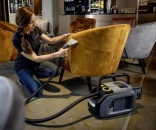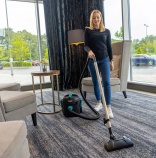Home › magazine › latest news › End of the manual vacuum cleaner?
End of the manual vacuum cleaner?
10th of October 2024As the carpet care industry becomes increasingly automated, is there still a need for a person
to manually operate a vacuum? Ann Laffeaty examines the role of the human cleaner in carpet care and asks whether manual vacuums will ever become a thing of the past.
Vacuuming a carpet can be a lengthy, laborious process. Pushing a piece of heavy machinery across a large floor will inevitably put a strain on the operator’s arms and back. And the job is a monotonous one that will take up a great deal of the cleaner’s working day while providing little in the way of work satisfaction.
As a result, a growing number of automated vacuum systems are now entering the market. Besides having the advantage of taking the physical strain away from the operator these can also be programmed to sweep a carpet at any hour of the day or night for added convenience.
So, does a manually-operated carpet care system still offer any advantages over an automated one in terms of efficiency, productivity and performance? And if not, are human cleaners still required for the task of vacuuming in some circumstances?
Comprehensive carpet care solutions require more than just a vacuum cleaner, says Kärcher’s senior consultant cleaning solutions and corporate account projects Gundula Braun. “The best machines and detergents should form part of a proper carpet care programme – and this points to the need for humans to be physically involved,” she said.
Human involvement
However, smart technologies are becoming increasingly prevalent, she admits. “Some machines now work autonomously to such a high degree that they relieve some of the cleaner’s burden in certain areas,” says Braun. “However, it is still necessary for a human operative to use the vacuum for tasks such as hoovering staircases and overhead areas – both operations that are currently beyond the capabilities of smart technology.”
A manually-operated solution tends to be more adaptable in unforeseen situations where a fast reaction is required, she says. “These machines also work well when carrying out tasks such as cleaning around furniture and under desks as well as vacuuming curtains, air vents and upholstery,” she adds.
“On the other hand, an automated vacuum cleaner can be a massive help in large floor areas where there are few obstacles such as in hotel corridors, large meeting rooms and ballrooms. Here a machine will provide significant benefits such as guaranteeing good results while also freeing up staff to concentrate on manual cleaning tasks.”
Different approaches
Humans and machines have different approaches when it comes to encountering items of furniture, she says. “Automated vacuum cleaners are programmed to adapt to certain obstacles although they are currently limited in their ability as to how to deal with them,” she said.
“A human cleaner may well move an obstacle out of the way and then return it to its previous place once the cleaning process is completed. And where obstacles can’t be moved, a human cleaner will be able to clean around them more efficiently than an automated machine. They also have a different range of actions and more tools at their disposal when it comes to overhead and above-floor vacuuming as well as cleaning in corners and small crevices.”
However, the use of autonomous cleaning systems is not limited by business hours or occupational regulations – and this is a key advantage, she adds. “In other words, machines can be programmed to clean overnight or whenever it is convenient,” said Braun. “They are not susceptible to the strains and injuries of human operators and they provide consistency in their cleaning scope and quality. But automated machines can only react within the parameters of their programming.”
An ideal solution is one that combines human cleaners with machines, she says. “All in all, autonomous machines provide great relief for personnel particularly when carrying out time-intensive, monotonous tasks,” said Braun. “In fact, manual and automated cleaning processes complement each other in creating a clean and healthy environment.”
Kärcher offers a range of manual vacuums including the BRS 43/500 C, which is said to be capable of cleaning large floor areas with minimal water and detergent and little operator effort. The company also manufactures the autonomous robotic vacuum cleaner KIRA CV 50 which features ultrasound sensors for glass detection; sensors to follow walls; drop sensors to avoid falling down staircases and a collision sensor. It can autonomously generate maps and plan paths and is claimed to reduce the amount of set-up time required.
Human operators have the advantage of being able to quickly identify different types of flooring and soil levels, says Truvox national sales manager Paul Robinson. “They can also move furniture and other obstructions out of the way to ensure effective cleaning,” he said. “And the variety of tools and accessories available makes it possible for human operators to obtain excellent results.”
However, the operator needs to be trained correctly in the use of a vacuum to minimise the risks of injury, he adds. “Hygiene has become a high priority in all premises since the pandemic which means cleaning has become more of a ‘front of house’ activity,” he said. “As a result, all machines need to be easy to use and attractive to look at.”
Repetitive movement
The company’s VTVe compact model is said to be simple to use and maintain. It is claimed to feature easily accessible on-board cleaning tools including a crevice and brush tool for detailed cleaning and for use in hard-to-reach areas.
Physical strain caused by repetitive actions and heavy lifting are an occupational hazard during carpet cleaning, says Cleanology’s marketing director Kate Lovell. “The back, shoulders and arms of the operator are particularly likely to be affected,” she said. “However, these risks can be averted when cleaners adopt good posture and take regular breaks.”
While the cleaning industry is increasingly embracing smarter technologies there are still several instances in which the need for operatives is important, she believes. “Humans are better equipped to deal with complex layouts such as stairs and high-up areas and can quickly respond to accidental spillages and stains,” she says. “And this type of immediate human intervention offers more flexibility than relying on machinery.”
Manually-operated machines are also likely to be more effective when working in cluttered areas while also being better suited to cleaning around corners and edges, adds Lovell. “And the presence of human operatives is reassuring in areas where customer interaction is important.”
Cleanology specialises in the provision of professional cleaning services, including carpet cleaning, across different industries.
So, will manual vacuums ever become a thing of the past? Or will there always be a place for a human in carpet cleaning? Smart technologies will certainly become smarter, according to Kärcher’s Gundula Braun. “However, in the foreseeable future we do not anticipate human
carpet cleaners being replaced because there are still situations in which even smart systems require attention and expertise,” she said.
No single solution
Robotic cleaning machines are not the total answer, agrees Paul Robinson from Truvox. “There will always be a place for humans in the cleaning industry because robots cannot easily determine different floor types, soil levels and other variables,” he said.
And Cleanology’s Kate Lovell believes that technology will increasingly be integrated into cleaning regimes. “Automated vacuums will handle routine cleaning in the future while human operatives will tackle the more complex and detail-oriented tasks,” she said. “But the likelihood is that there will always be scenarios where human involvement is vital - and even preferred.”









